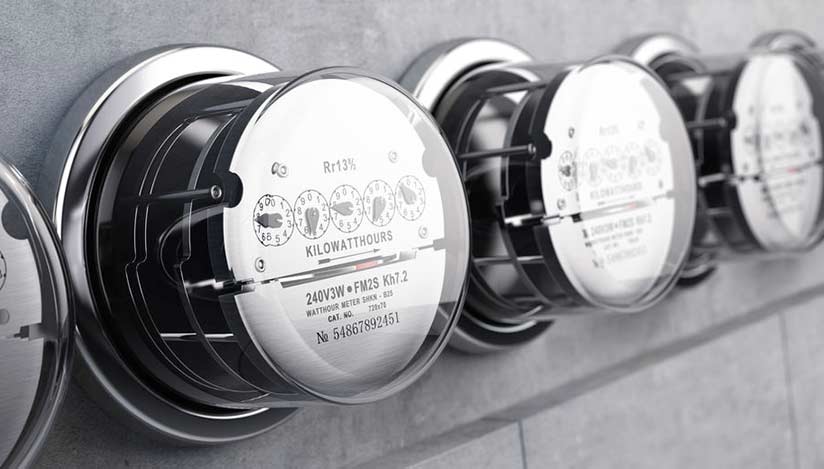Solar power is a great way for homeowners to save money by generating their own electricity and reducing their reliance on increasingly costly energy generated by local utilities. But there’s a big problem with solar energy: If you don’t use electricity as it’s generated by your solar power system, that energy is lost. Technically, that electricity is never generated in the first place. While we won’t get too technical here, it’s easy to see the key issue here.
Solar power systems generate electricity during the day, but most households use the bulk of their electricity in the evening. This severely undermines the usefulness of solar power. That’s where net energy metering (NEM) comes into play.
Net energy metering is a system where unused energy can be sent to the local utility grid and credit which offsets the cost of electricity used later.
Back in the early 1980s, a few individuals and organizations in the United States were beginning to experiment with alternative forms of energy generation, primarily solar and wind power. These systems were typically connected to the energy grid, as consumers usually needed a source of electricity when their needs exceeded their generation capacity. But the nature of these systems meant that when their solar or wind power systems generated excess electricity, it was sent to the grid.
Consumers began lobbying utility companies and local governments, asking to be compensated for the electricity they generated and sent to the local grid. They proposed a system that would allow them to time-shift their energy usage—much like recording a TV show when it airs, and then watching it later when it’s convenient. They could send energy to the grid when they didn’t need it, and then be paid back later with electricity from the grid.
Over the last 35 years, 44 states have passed laws codifying this system, known as ‘net energy metering.’ The details of these laws vary from state to state regarding the:
- Percentage of homeowners who can ‘subscribe’ to net metering
- Maximum generation capacity
- Unused credits can be rolled over month-to-month or year-to-year
- Compensation rate for electricity sent to the grid
California’s net metering policy is favorable to homeowners, though it’s been updated recently to address long-term concerns for utility companies and their customers.
California enacted its first net energy metering in 2006. Originally, this NEM policy was very straightforward and generous to homeowners. Having a solar power system connected to the grid was free, the credit amount for every kWh of energy sent to the grid was equal to the rate charged by utilities, and fees were minimal.
This was by design, as offsetting the very high prices of early solar power systems required a great deal of incentivization. For perspective, the Solar Energy Industries Association (SEIA) estimates that solar power installation costs have dropped by 47% in just the past 5 years.
But in the last decade, California’s solar power production rate has soared. The Solar Energy Industries Association (SEIA) estimates that 16.68% of the state’s electricity was sourced from solar power in 2017—the highest rate in the country.
This presents something of a problem for energy utilities and their customers in the long-run. When a homeowner reduces their reliance on utility-sourced electricity, their payments to their local utility also decrease. A very conscientious homeowner may well be able to ‘zero out’ their energy bill and pay nothing—even though they still rely on the energy grid, which requires maintenance, repair, and expansion. If the current trend continued, those without solar power—either by choice or because they didn’t have the means or option of installing solar power—would bear an outsized share of the financial burden of maintaining the state’s energy grid.
In 2016, the California Public Utilities Commission (CPUC) rolled out NEM 2.0, a revamped net energy metering system.
Homeowners who install solar power systems today enjoy many of the benefits of NEM that have motivated Californians to go solar for more than a decade. But there are four key changes that impact new adopters of solar power:
- You must pay a one-time ‘interconnection fee’ to have your system connected to the energy grid. This fee is about $150.
- You must enroll in your utility company’s time-of-use pricing.
- You are compensated for the energy you send to the grid at a rate 2 to 3 cents lower than the retail rate. These deducted fees are used to support a variety of state programs.
- A small percentage of energy charges are ‘non-bypassable,’ meaning that they cannot be offset with energy credits. This is to ensure that the cost of maintaining utility energy grids is not paid for solely by non-solar customers.
Even under the new NEM 2.0 system, it is still possible to nearly zero out your energy. Capital City Solar’s customers average a 75% reduction in their energy costs. Some even manage to finish the year with a net surplus of electricity on their annual true-up settlement bill, meaning they produced more electricity than they sold.
Customers are credited for this excess electricity at a ‘net surplus compensation’ (NSC) rate specified by their utility. As of December 2018, PG&E’s NSC rate is 2.951 cents/kWh, while SMUD’s NSC rate is 5.52 cents/kWh.
NEM programs in California and elsewhere will continue to evolve over time as more homeowners install solar power systems. The popularity of these programs, and the efforts of solar industry and customer advocacy groups mean that future adopters of solar power will continue to enjoy the financial benefits of net energy metering for many years to come.
